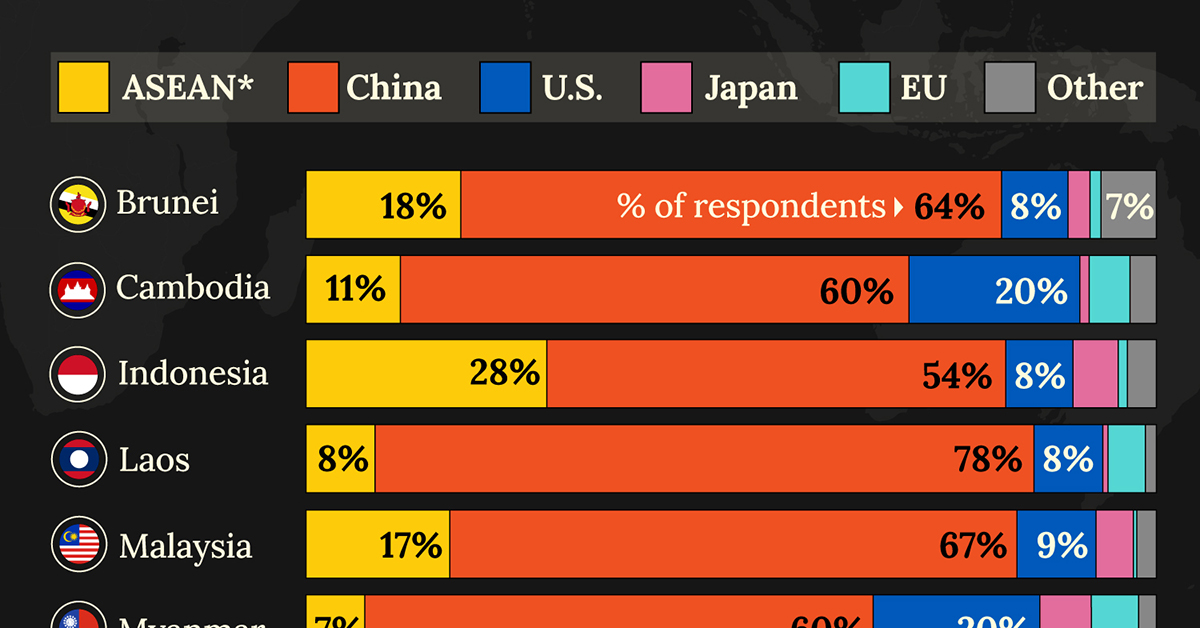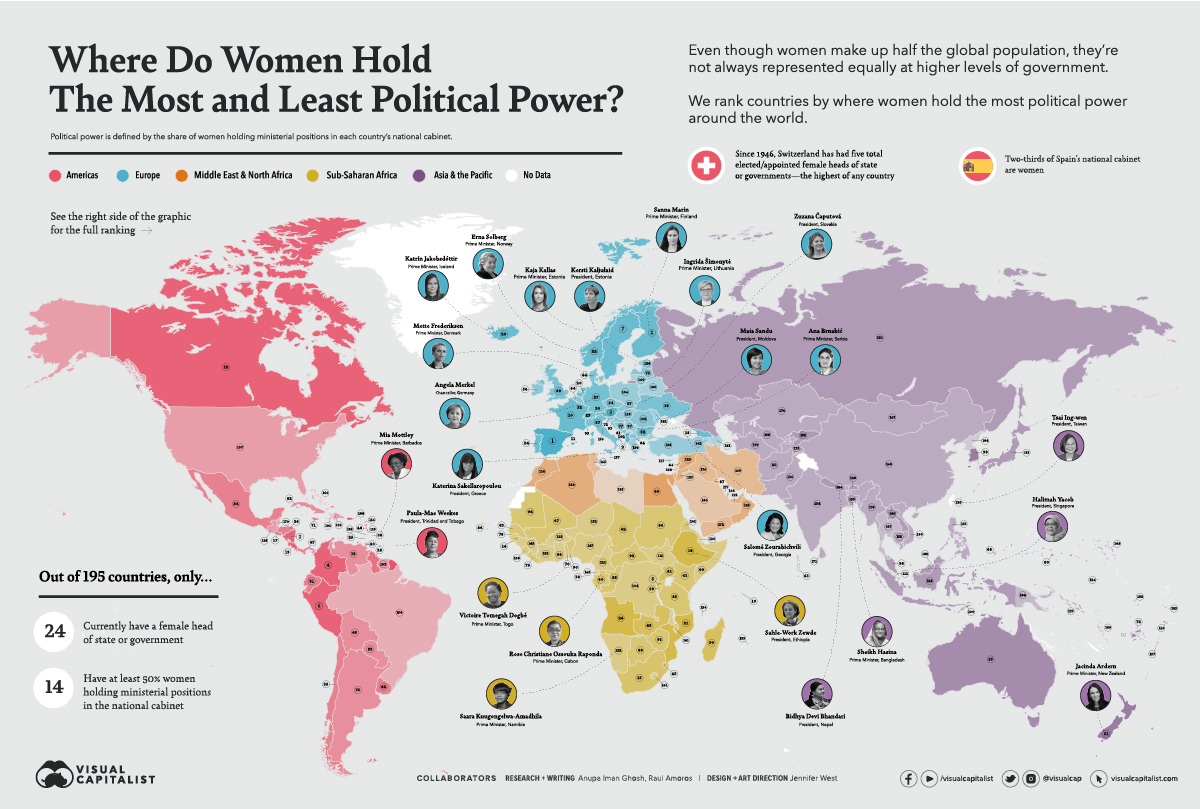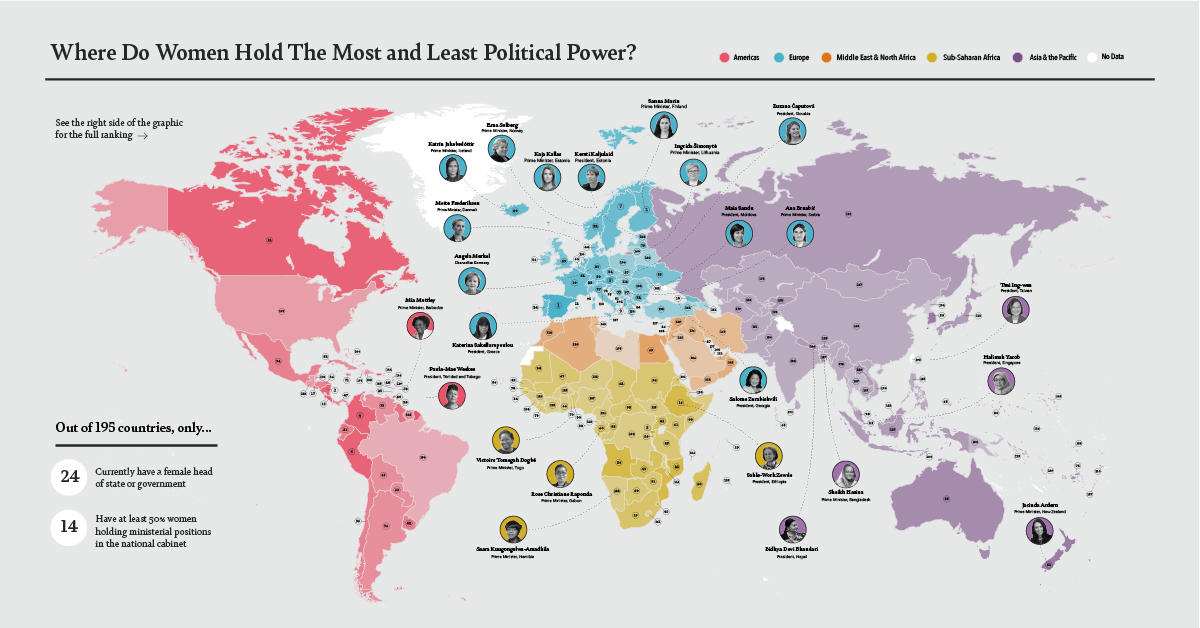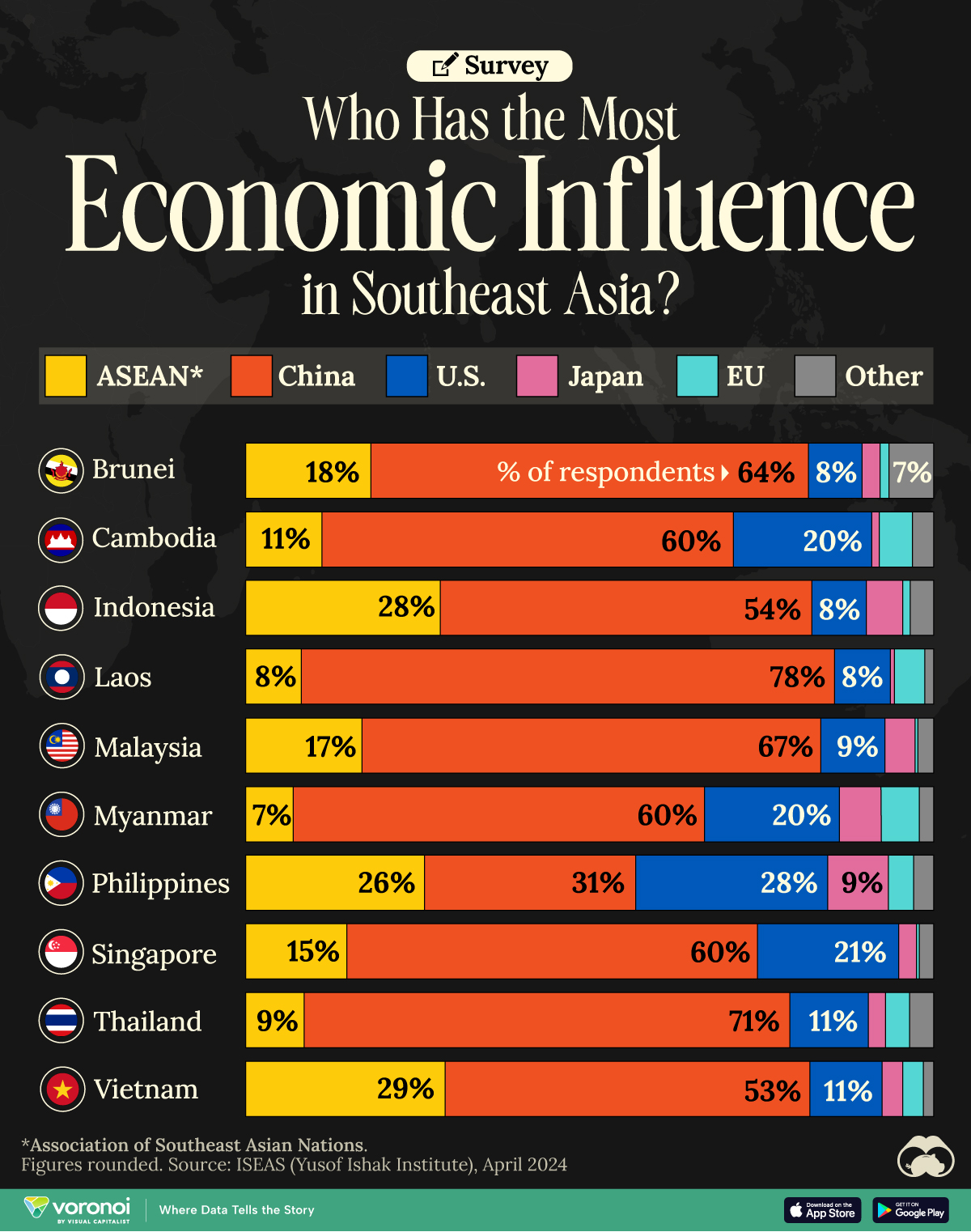Politics
Mapped: Where Women Hold the Most and Least Political Power
Where Women Hold the Most and Least Political Power
View the medium or highest resolution version of this map to explore all countries.
From the right to vote, to owning property and assets, women’s legal and economic rights have come a long way.
International Women’s Day, held annually on March 8th is an opportunity to commemorate global improvements around gender equality. One big driver for this is women’s political participation—however, progress in this area has not been distributed evenly worldwide.
Women’s Political Power: Share of Ministers in Cabinets
In this map, we dig into how much political power women hold around the world. The Council on Foreign Relations pulls the latest data from UN Women and the Inter-Parliamentary Union (IPU) to examine the shares of women holding ministerial positions in 195 national cabinets.
Here are the top five countries with the highest percentages of women’s political power:
- 🇪🇸 Spain: 66.7%
- 🇫🇮 Finland: 61.1%
- 🇳🇮 Nicaragua: 58.8%
- 🇨🇴 Colombia: 57.9%
- 🇦🇹 Austria: 57.1%
Even though women make up half the global population, they’re not always represented at higher levels of government. Only 14 countries have at least 50% women holding ministerial positions in the national cabinet.
| Country | Region | % Women in National Cabinet |
|---|---|---|
| Afghanistan | Asia-Pacific | 9.7 |
| Albania | Europe | 53.3 |
| Algeria | Middle East/North Africa | 15.2 |
| Andorra | Europe | 50.0 |
| Angola | Sub-Saharan Africa | 40.0 |
| Antigua and Barbuda | Americas | 15.4 |
| Argentina | Americas | 22.7 |
| Armenia | Europe | 7.1 |
| Australia | Asia-Pacific | 26.7 |
| Austria | Europe | 57.1 |
| Azerbaijan | Europe | 3.0 |
| Bahamas | Americas | 6.7 |
| Bahrain | Middle East/North Africa | 4.4 |
| Bangladesh | Asia-Pacific | 7.7 |
| Barbados | Americas | 26.1 |
| Belarus | Europe | 3.5 |
| Belgium | Europe | 25.0 |
| Belize | Americas | 6.3 |
| Benin | Sub-Saharan Africa | 20.8 |
| Bhutan | Asia-Pacific | 10.0 |
| Bolivia | Americas | 25.0 |
| Bosnia and Herzegovina | Europe | 22.2 |
| Botswana | Sub-Saharan Africa | 21.1 |
| Brazil | Americas | 9.1 |
| Brunei | Asia-Pacific | 0.0 |
| Bulgaria | Europe | 36.8 |
| Burkina Faso | Sub-Saharan Africa | 14.3 |
| Burundi | Sub-Saharan Africa | 26.1 |
| Cambodia | Asia-Pacific | 9.4 |
| Cameroon | Sub-Saharan Africa | 14.9 |
| Canada | Americas | 50.0 |
| Cape Verde | Sub-Saharan Africa | 21.4 |
| Central African Republic | Sub-Saharan Africa | 20.0 |
| Chad | Sub-Saharan Africa | 25.9 |
| Chile | Americas | 33.3 |
| China | Asia-Pacific | 6.5 |
| Colombia | Americas | 57.9 |
| Comoros | Sub-Saharan Africa | 8.3 |
| Costa Rica | Americas | 50.0 |
| Cote d'Ivoire | Sub-Saharan Africa | 12.8 |
| Croatia | Europe | 20.0 |
| Cuba | Americas | 21.9 |
| Cyprus | Europe | 15.4 |
| Czech Republic | Europe | 28.6 |
| Democratic Republic of Congo | Sub-Saharan Africa | 17.4 |
| Denmark | Europe | 31.6 |
| Djibouti | Sub-Saharan Africa | 13.0 |
| Dominica | Americas | 31.3 |
| Dominican Republic | Americas | 17.4 |
| East Timor | Asia-Pacific | 18.2 |
| Ecuador | Americas | 37.9 |
| Egypt | Middle East/North Africa | 24.2 |
| El Salvador | Americas | 47.1 |
| Equatorial Guinea | Sub-Saharan Africa | 7.1 |
| Eritrea | Sub-Saharan Africa | 17.7 |
| Estonia | Europe | 14.3 |
| Eswatini | Sub-Saharan Africa | 31.6 |
| Ethiopia | Sub-Saharan Africa | 47.6 |
| Fiji | Asia-Pacific | 23.1 |
| Finland | Europe | 61.1 |
| France | Europe | 52.9 |
| Gabon | Sub-Saharan Africa | 26.1 |
| Gambia | Sub-Saharan Africa | 22.2 |
| Georgia | Europe | 45.5 |
| Germany | Europe | 40.0 |
| Ghana | Sub-Saharan Africa | 25.0 |
| Greece | Europe | 11.1 |
| Grenada | Americas | 41.7 |
| Guatemala | Americas | 13.3 |
| Guinea | Sub-Saharan Africa | 10.8 |
| Guinea-Bissau | Sub-Saharan Africa | 50.0 |
| Guyana | Americas | 40.0 |
| Haiti | Americas | - |
| Honduras | Americas | 33.3 |
| Hungary | Europe | 15.4 |
| Iceland | Europe | 40.0 |
| India | Asia-Pacific | 12.5 |
| Indonesia | Asia-Pacific | 14.3 |
| Iran | Middle East/North Africa | 6.5 |
| Iraq | Middle East/North Africa | 4.6 |
| Ireland | Europe | 26.7 |
| Israel | Middle East/North Africa | 16.7 |
| Italy | Europe | 33.3 |
| Jamaica | Americas | 23.5 |
| Japan | Asia-Pacific | 15.8 |
| Jordan | Middle East/North Africa | 13.8 |
| Kazakhstan | Russia/Central Asia | 5.0 |
| Kenya | Sub-Saharan Africa | 26.1 |
| Kiribati | Asia-Pacific | 0.0 |
| Kosovo | Europe | - |
| Kuwait | Middle East/North Africa | 21.4 |
| Kyrgyzstan | Russia/Central Asia | 9.5 |
| Laos | Asia-Pacific | 11.1 |
| Latvia | Europe | 23.1 |
| Lebanon | Middle East/North Africa | 31.6 |
| Lesotho | Sub-Saharan Africa | 7.4 |
| Liberia | Sub-Saharan Africa | 22.2 |
| Libya | Middle East/North Africa | - |
| Liechtenstein | Europe | 40.0 |
| Lithuania | Europe | 7.7 |
| Luxembourg | Europe | 29.4 |
| Madagascar | Sub-Saharan Africa | 30.0 |
| Malawi | Sub-Saharan Africa | 11.1 |
| Malaysia | Asia-Pacific | 18.5 |
| Maldives | Asia-Pacific | 25.9 |
| Mali | Sub-Saharan Africa | 25.0 |
| Malta | Europe | 11.8 |
| Marshall Islands | Asia-Pacific | 10.0 |
| Mauritania | Sub-Saharan Africa | 20.0 |
| Mauritius | Sub-Saharan Africa | 12.5 |
| Mexico | Americas | 35.0 |
| Micronesia | Asia-Pacific | 22.2 |
| Moldova | Europe | 11.1 |
| Monaco | Europe | 20.0 |
| Mongolia | Asia-Pacific | 6.7 |
| Montenegro | Europe | 22.2 |
| Morocco | Middle East/North Africa | 15.8 |
| Mozambique | Sub-Saharan Africa | 42.9 |
| Myanmar | Asia-Pacific | 3.9 |
| Namibia | Sub-Saharan Africa | 14.8 |
| Nauru | Asia-Pacific | 14.3 |
| Nepal | Asia-Pacific | 10.5 |
| Netherlands | Europe | 44.4 |
| New Zealand | Asia-Pacific | 30.0 |
| Nicaragua | Americas | 58.8 |
| Niger | Sub-Saharan Africa | 12.8 |
| Nigeria | Sub-Saharan Africa | 10.3 |
| North Korea | Asia and the Pacific | - |
| North Macedonia | Europe | 21.7 |
| Norway | Europe | 42.9 |
| Oman | Middle East/North Africa | 11.1 |
| Pakistan | Asia-Pacific | 12.0 |
| Palau | Asia-Pacific | 25.0 |
| Panama | Americas | 31.6 |
| Papua New Guinea | Asia-Pacific | 0.0 |
| Paraguay | Americas | 29.4 |
| Peru | Americas | 55.0 |
| Philippines | Asia-Pacific | 8.6 |
| Poland | Europe | 17.4 |
| Portugal | Europe | 42.1 |
| Qatar | Middle East/North Africa | 7.1 |
| Republic of Congo | Sub-Saharan Africa | 21.2 |
| Romania | Europe | 17.7 |
| Russia | Russia/Central Asia | 12.9 |
| Rwanda | Sub-Saharan Africa | 53.6 |
| Saint Kitts and Nevis | Americas | 11.1 |
| Saint Lucia | Americas | 15.4 |
| Saint Vincent and the Grenadines | Americas | 0.0 |
| Samoa | Asia-Pacific | 16.7 |
| San Marino | Europe | 10.0 |
| Sao Tome and Principe | Sub-Saharan Africa | 33.3 |
| Saudi Arabia | Middle East/North Africa | 0.0 |
| Senegal | Sub-Saharan Africa | 21.9 |
| Serbia | Europe | 19.1 |
| Seychelles | Sub-Saharan Africa | 45.5 |
| Sierra Leone | Sub-Saharan Africa | 17.2 |
| Singapore | Asia-Pacific | 16.7 |
| Slovakia | Europe | 26.7 |
| Slovenia | Europe | 23.5 |
| Solomon Islands | Asia-Pacific | 5.0 |
| Somalia | Sub-Saharan Africa | 18.5 |
| South Africa | Sub-Saharan Africa | 48.3 |
| South Korea | Asia-Pacific | 33.3 |
| South Sudan | Sub-Saharan Africa | 15.6 |
| Spain | Europe | 66.7 |
| Sri Lanka | Asia-Pacific | 6.3 |
| Sudan | Sub-Saharan Africa | 20.0 |
| Suriname | Americas | 17.7 |
| Sweden | Europe | 54.6 |
| Switzerland | Europe | 42.9 |
| Syria | Middle East/North Africa | 13.3 |
| Taiwan | Asia-Pacific | - |
| Tajikistan | Russia/Central Asia | 5.9 |
| Tanzania | Sub-Saharan Africa | 21.7 |
| Thailand | Asia-Pacific | 0.0 |
| Togo | Sub-Saharan Africa | 24.0 |
| Tonga | Asia-Pacific | 8.3 |
| Trinidad and Tobago | Americas | 33.3 |
| Tunisia | Middle East/North Africa | 6.9 |
| Turkey | Europe | 11.8 |
| Turkmenistan | Russia/Central Asia | 3.7 |
| Tuvalu | Asia-Pacific | 0.0 |
| Uganda | Sub-Saharan Africa | 33.3 |
| Ukraine | Europe | 35.3 |
| United Arab Emirates | Middle East/North Africa | 16.7 |
| United Kingdom | Europe | 30.4 |
| United States | Americas | 17.4 |
| Uruguay | Americas | 33.3 |
| Uzbekistan | Russia/Central Asia | 8.0 |
| Vanuatu | Asia-Pacific | 0.0 |
| Venezuela | Americas | 23.5 |
| Vietnam | Asia-Pacific | 0.0 |
| Yemen | Middle East/North Africa | 6.3 |
| Zambia | Sub-Saharan Africa | 32.3 |
| Zimbabwe | Sub-Saharan Africa | 20.8 |
On the flip side, nine countries have 0% women in their national cabinet, such as Saudi Arabia and Thailand.
The silver lining to this is that Saudi Arabia is actually improving in some areas of women’s economic rights in recent years, such as granting more freedom of movement to travel and prohibiting employment discrimination on the basis on gender.
The Most Powerful Women: Female Heads of State/Government
From Indira Gandhi to Margaret Thatcher, many women have held notable and influential leadership positions in the past, serving as tours de force for the global economy.
Presently, there are only 24 countries with a female head of state or government. Moldova’s Maia Sandu is the latest to rise into a Presidential role as of December 2020. Here’s who the rest are, and their titles.
| Country | Name | Title |
|---|---|---|
| 🇧🇩 Bangladesh | Sheikh Hasina | Prime Minister |
| 🇧🇧 Barbados | Mia Mottley | Prime Minister |
| 🇩🇰 Denmark | Mette Frederiksen | Prime Minister |
| 🇪🇪 Estonia | Kersti Kaljulaid | President |
| 🇪🇪 Estonia | Kaja Kallas | Prime Minister |
| 🇪🇹 Ethiopia | Sahle-Work Zewde | President |
| 🇫🇮 Finland | Sanna Marin | Prime Minister |
| 🇬🇦 Gabon | Rose Christiane Ossouka Raponda | Prime Minister |
| 🇬🇪 Georgia | Salomé Zourabichvili | President |
| 🇩🇪 Germany | Angela Merkel | Chancellor |
| 🇬🇷 Greece | Katerina Sakellaropoulou | President |
| 🇮🇸 Iceland | Katrín Jakobsdóttir | Prime Minister |
| 🇱🇹 Lithuania | Ingrida Šimonytė | Prime Minister |
| 🇲🇩 Moldova | Maia Sandu | President |
| 🇳🇦 Namibia | Saara Kuugongelwa-Amadhila | Prime Minister |
| 🇳🇵 Nepal | Bidhya Devi Bhandari | President |
| 🇳🇿 New Zealand | Jacinda Ardern | Prime Minister |
| 🇳🇴 Norway | Erna Solberg | Prime Minister |
| 🇷🇸 Serbia | Ana Brnabić | Prime Minister |
| 🇸🇬 Singapore | Halimah Yacob | President |
| 🇸🇰 Slovakia | Zuzana Čaputová | President |
| 🇹🇬 Togo | Victoire Tomegah Dogbé | Prime Minister |
| 🇹🇹 Trinidad and Tobago | Paula-Mae Weekes | President |
| 🇹🇼 Taiwan | Tsai Ing-wen | President |
Last updated: Mar 2, 2021
As the chancellor of Germany, Angela Merkel holds the longest consecutive term of all female heads of state/government. With 15 years under her belt, Merkel is largely seen as a de facto leader of Europe. However, she intends to step down as chancellor after her term ends in September 2021.
Since 1946, Switzerland has had five total elected or appointed female heads of state or governments—the highest of any country. Simonette Sommaruga, the most recent female president of the nation, was only succeeded in the new year and dropped off this list.
Glass Ceiling in Politics?
While women have made strides in reaching their political potential worldwide, it’s interesting to note that they generally have a harder time ascending to office in larger countries compared to smaller economies.
For example, Estonia is the first country to have two female heads of state/government with both the president and prime minister positions being filled by women. On the flipside, many other countries have never had even one female head of state.
That said, shares of women holding seats in national legislatures are growing worldwide, which means that progress in these upper levels may be just around the corner.
“No country can ever truly flourish if it stifles the potential of its women and deprives itself of the contributions of half its citizens.”
—Michelle Obama
China
Which Countries Have the Most Economic Influence in Southeast Asia?
One country dominates this survey of who has the most economic influence in the region.

Countries With the Most Economic Influence in Southeast Asia
This was originally posted on our Voronoi app. Download the app for free on iOS or Android and discover incredible data-driven charts from a variety of trusted sources.
This chart visualizes the results of a 2024 survey conducted by the ASEAN Studies Centre at the ISEAS-Yusof Ishak Institute.
Nearly 2,000 respondents from 10 countries were asked to select which country/region they believe has the most influential economic power in Southeast Asia.
The countries surveyed are all member states of the Association of Southeast Asian Nations (ASEAN), a political and economic union of 10 countries in Southeast Asia.
Southeast Asia Perceptions: Who’s Got Economic Influence?
Across all ASEAN nations, China is regarded as the region’s most influential economic power.
Laos and Thailand had the highest share of respondents picking China, at 78% and 71% respectively. As the report points out, China is Laos’ largest foreign investor as well as its top export market.
| Country | 🇨🇳 China | 🌏 ASEAN | 🇺🇸 U.S. |
|---|---|---|---|
| 🇧🇳 Brunei | 64% | 18% | 8% |
| 🇰🇭 Cambodia | 60% | 11% | 20% |
| 🇮🇩 Indonesia | 54% | 28% | 8% |
| 🇱🇦 Laos | 78% | 8% | 8% |
| 🇲🇾 Malaysia | 67% | 17% | 9% |
| 🇲🇲 Myanmar | 60% | 7% | 20% |
| 🇵🇭 Philippines | 31% | 26% | 28% |
| 🇸🇬 Singapore | 60% | 15% | 21% |
| 🇹🇭 Thailand | 71% | 9% | 11% |
| 🇻🇳 Vietnam | 53% | 29% | 11% |
Note: Percentages are rounded.
Other ASEAN countries usually score highly as well, along with the United States.
It’s only in the Philippines, where China (31%), the U.S. (28%) and ASEAN (26%) were perceived as having a similar amount of influence.
ASEAN, Japan, and the EU
Filipinos also rated Japan’s economic influence the highest (9%) compared to those surveyed in other ASEAN countries. In 2023, the Southeast Asian bloc celebrated 50 years of friendship with Japan, marking it as one of their most important “dialogue partners.”
| Country | 🇯🇵 Japan | 🇪🇺 EU | 🌐 Other |
|---|---|---|---|
| 🇧🇳 Brunei | 3% | 1% | 7% |
| 🇰🇭 Cambodia | 1% | 5% | 3% |
| 🇮🇩 Indonesia | 5% | 1% | 3% |
| 🇱🇦 Laos | 1% | 4% | 1% |
| 🇲🇾 Malaysia | 4% | 0% | 2% |
| 🇲🇲 Myanmar | 6% | 6% | 2% |
| 🇵🇭 Philippines | 9% | 4% | 3% |
| 🇸🇬 Singapore | 3% | 0% | 2% |
| 🇹🇭 Thailand | 3% | 4% | 4% |
| 🇻🇳 Vietnam | 3% | 3% | 2% |
Note: Percentages are rounded. Other countries include: Australia, South Korea, India, and the UK.
The EU also received single-percentage responses, its highest share coming from Myanmar (6%), Cambodia (5%), and Laos (4%).
Finally, the report contrasted China’s robust economic influence with concerns about its growing impact in the region. Respondents from Vietnam (88%), Myanmar (88%), and Thailand (80%) had the highest levels of concern, despite their countries’ strong trade ties with China.
-

 Personal Finance1 week ago
Personal Finance1 week agoVisualizing the Tax Burden of Every U.S. State
-

 Misc6 days ago
Misc6 days agoVisualized: Aircraft Carriers by Country
-

 Culture6 days ago
Culture6 days agoHow Popular Snack Brand Logos Have Changed
-

 Mining1 week ago
Mining1 week agoVisualizing Copper Production by Country in 2023
-

 Misc1 week ago
Misc1 week agoCharted: How Americans Feel About Federal Government Agencies
-

 Healthcare1 week ago
Healthcare1 week agoWhich Countries Have the Highest Infant Mortality Rates?
-

 Demographics1 week ago
Demographics1 week agoMapped: U.S. Immigrants by Region
-

 Maps1 week ago
Maps1 week agoMapped: Southeast Asia’s GDP Per Capita, by Country



















